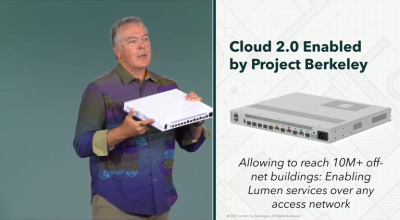- Lumen revealed its new “Project Berkeley” interface device to expand NaaS access
- Enterprises will be able to use the device from off-net sites – no matter what kind of internet connection they have
- The idea is to prep enterprises for the “Cloud 2.0 AI economy,” said Lumen CTO Dave Ward
Lumen has a plan to serve up its network-as-a-service (NaaS) platform to more customers, regardless of their existing internet connection.
At the company’s Analyst Forum, Lumen CTO Dave Ward unveiled “Project Berkeley,” a network interface device that essentially expands the company’s NaaS services, like on-demand internet, Ethernet and IP VPN, to off-net sites using any access type. Those access types can be 5G, fiber, copper, fixed wireless access, satellite and more.
The device, which looks like a typical internet router, has a “Swiss Army knife as a front panel,” Ward said. “[For] all of my other service provider partners in the industry, I now run the services on their network and we connect this back to Lumen’s backbone.”

Lumen, in addition to supplying private fiber connectivity for hyperscalers, has been growing its NaaS platform for some time. It launched its first offering in 2023 and now counts over 1,000 enterprise NaaS customers. Now, the company aims to bring its connectivity products to over 10 million off-net buildings, said Ward. The device will also allow hyperscalers to integrate and sell these products in their respective marketplaces.
Digital twinning
He added Project Berkeley leverages digital twin technology, which lets Lumen have “a full replicate understanding of exactly what’s going on in this device running out of our cloud.”
News of this device isn’t too surprising given how Lumen is trying to make its network services more accessible and cloud compatible. For instance, Lumen in May introduced its Lumen Connectivity Fabric, a suite of services that can all be remotely managed via the cloud and the company’s so-called “fabric port,” a physical device that Lumen said can support “thousands of services.”
According to Ward, Project Berkeley “becomes our fabric port on-prem,” meaning Lumen can provide “full bandwidth, latency [and] redundancy control” not only between data centers and cloud providers but also from one premises to another, or from the prem to data center and cloud.
The goal of the product, which Lumen expects to roll out in the first half of 2026, is to ensure enterprises are prepared for what Ward called the “Cloud 2.0 AI economy.”
“There’s an absolutely, completely different way to build enterprise WAN networks,” he explained. “We really have to get beyond the notion of a flat internet and flat technology to get the cloud, waves and fiber…we’re going to have layers of services and control of these different layers and that has not been seen before.”
Lumen’s network expansion
As Lumen cultivates its NaaS arsenal, it continues to build out its physical fiber network to support over $9 billion in Private Connectivity Fabric (PCF) deals.
The company to-date has deployed roughly 2,600 miles of fiber across 26 routes, said EVP of Enterprise Operations Kye Prigg, and expects to reach 16.6 million total intercity fiber miles by end of 2025.
But it’s not just the number of fiber miles that matter. Prigg also noted Lumen has finished construction of 144 In-Line Amplifier (ILA) shelters, which essentially serve as signal boosters for the fiber backbone.
“Without these shelters, you can’t light the fiber in the ground,” he said, and Lumen eventually hopes to have over 500 shelters in operation to accommodate the enterprise’s increasing appetite for fiber.
“Our consumers are also lighting up and consuming the fiber in the ground I would say at a record pace,” Prigg added.
